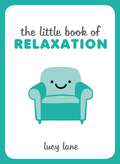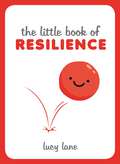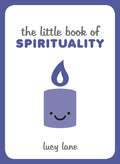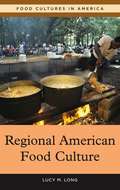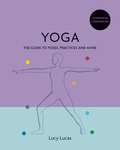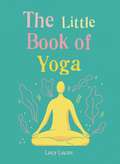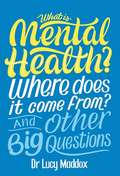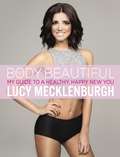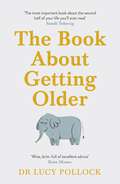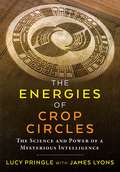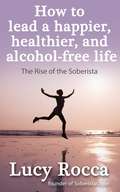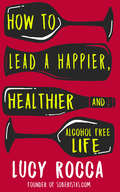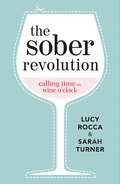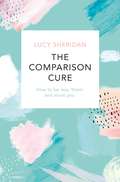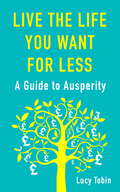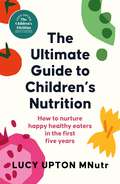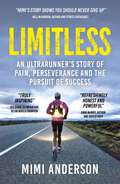- Table View
- List View
The Little Book of Relaxation
by Lucy LaneThis essential pocket-sized companion is packed with inspiring quotations from writers, spiritual leaders and philosophers, along with simple but effective tips to help you bring moments of calm into your daily life. The Little Book of Relaxation will benefit the mind and heart and make a real difference to every day.
The Little Book of Relaxation
by Lucy LaneThis essential pocket-sized companion is packed with inspiring quotations from writers, spiritual leaders and philosophers, along with simple but effective tips to help you bring moments of calm into your daily life. The Little Book of Relaxation will benefit the mind and heart and make a real difference to every day.
The Little Book of Resilience (The\little Book Of Ser.)
by Lucy LaneLife’s journey isn’t always a stroll in the sunshine, but there are ways of weathering the storms. This pocket-sized book of heartening quotations and simple but effective tips will help you to summon your inner reserves and bounce back from adversity stronger than ever.
The Little Book of Spirituality: Tips, Techniques and Quotes to Help You Find Inner Peace
by Lucy LaneConnect to your inner self and the world around you with this uplifting pocket guide. Filled with inspiring quotes, insights into a wide range of philosophies and useful tips on how to practise spirituality in your everyday life, this little book will help you along your own spiritual journey and instil within you a sense of peace and happiness.
Regional American Food Culture
by Lucy LongFor general readers, Long (international studies and American culture studies, Bowling Green State U.) provides an overview of regional American food cultures. She discusses the history of food cultures in various regions of the US, and major foods and ingredients, cooking traditions, typical meals, dining habits, special occasions, and diet and health in the East, South, Midwest, and West, with some recipes. Annotation c2010 Book News, Inc., Portland, OR (booknews.com)
Godsfield Companion: The guide to poses, practices and more
by Lucy LucasA comprehensive guide to yoga, its history, philosophy and how to incorporate the practice into your everyday life.Expert yoga practitioner Lucy Lucas offers fresh insight into the history, philosophy and science of yoga, helping you to truly understand its ancient wisdom.Includes more than 50 step-by-step sequences.CONTENTSChapter 1: What is Yoga?Including The history of yoga and Yoga philosophyChapter 2: How Yoga WorksIncluding How we move and why it matters, How yoga impacts upon the brain and A guide to posesChapter 3: How to Live Your YogaIncluding A practice for hip strength and mobility, A gentle flow for boundaries and Letting in more of the good
Godsfield Companion: The guide to poses, practices and more
by Lucy LucasA comprehensive guide to yoga, its history, philosophy and how to incorporate the practice into your everyday life.Expert yoga practitioner Lucy Lucas offers fresh insight into the history, philosophy and science of yoga, helping you to truly understand its ancient wisdom.Includes more than 50 step-by-step sequences.CONTENTSChapter 1: What is Yoga?Including The history of yoga and Yoga philosophyChapter 2: How Yoga WorksIncluding How we move and why it matters, How yoga impacts upon the brain and A guide to posesChapter 3: How to Live Your YogaIncluding A practice for hip strength and mobility, A gentle flow for boundaries and Letting in more of the good
The Little Book of Yoga: Harness the ancient practice to boost your health and wellbeing
by Lucy LucasYoga is an ancient practice, harnessing the breath and strengthening the body to boost physical health and mental wellbeing. Whether you want to relax, become more flexible or get in touch with your spiritual side, this book will show you the way. Find out which type of yoga is right for you, experience the calming effects of yoga breathing techniques and learn simple daily practices that will make you feel strong, calm and focused.In this book, expert practitioner Lucy Lucas shows you how to integrate yoga into your life, simply, every day.
The Little Book of Yoga: Harness the ancient practice to boost your health and wellbeing
by Lucy LucasYoga is an ancient practice, harnessing the breath and strengthening the body to boost physical health and mental wellbeing. Whether you want to relax, become more flexible or get in touch with your spiritual side, this book will show you the way. Find out which type of yoga is right for you, experience the calming effects of yoga breathing techniques and learn simple daily practices that will make you feel strong, calm and focused.In this book, expert practitioner Lucy Lucas shows you how to integrate yoga into your life, simply, every day.
What is Mental Health? Where does it come from? And Other Big Questions (And Other Big Questions)
by Lucy MaddoxExploring and explaining the range of mental health, from wellbeing through to mental health problems, in a non-stigmatising, accessible and accurate way.Mental health gets talked about a lot, but what is it? And where does it come from?This book explains what mental health is, considering how it relates to lots of different experiences, from how we manage really big feelings, to how we get on with each other, how we make choices and how we handle stressful situations. The book thoughtfully examines the things that can help us look after our mental health and the things that might make it feel worse. It has suggestions for the support on offer if we feel we're struggling.It includes specially-written contributions from Chamique Holdsclaw, US gold medallist basketballer, academics Dr Suzi Gage and Professor Marianne Van Den Bree, poet Fisky, artists Christine Rai and Liz Atkin, mental health advocate Chineye Njoku and Dr Alan Cooklin, psychiatrist and founder of the charity Our Time which helps children whose parents experience mental health problems.Aimed at young people aged 10 and upwards.Part of the groundbreaking and important 'And Other Big Questions' series, which offers balanced and considered views on the big issues we face in the world we live in today.Other titles in the series include:What is Gender? How does it define us?What is Feminism? Why do we need it?What is Consent? Why is it important?What is Masculinity? Why does it matter?
Be Body Beautiful: Look and feel your best with my guide to a healthy, happy new you
by Lucy MecklenburghGet fitter and and healthier from your own home with Lucy Mecklenburgh's energising diet and fitness bookWhen Lucy Mecklenburgh ditched the junk food and embarked on a journey to get fit, it was the best decision she ever made - the physical and mental results are clear to see. Now Lucy is on a mission to get every woman looking and feeling her best - and the good news is, we can achieve it all at home.With the help of her nutritionist and personal trainer, Lucy shares the six-week diet and fitness plan that changed her life. Providing a lasting, lifestyle-based approach, this book is grounded in the latest science to help you become 'body beautiful' - because decisions we make about our diet and life impact hugely on how we look and feel.Discover how to:· Nourish your body with Lucy's favourite beauty food· Energize your exercise routines with home workouts· Boost confidence with Lucy's top ten tips· Motivate yourself to make lasting changes· Break bad habits for good'I'm probably the happiest and most content I've ever been, but I've had to work really hard on my body and on my confidence to get here. This book is my personal journey, but it's also a diet and lifestyle plan that will help you transform your body and live a long, strong, healthy and happy life'Be Body Beautiful tells of Lucy's rollercoaster last few years and how she learned to take control of her body and her life. For anyone who wants to transform themselves for good, this book will be a life changing read.
The Book About Getting Older: The essential comforting guide to ageing with wise advice for the highs and lows
by Lucy PollockThe honest, compassionate and vital guide to getting older, from dementia to finances, medication to care homes'The most important book about the second half of your life you'll ever read. I wish everyone in the UK could be under Dr Lucy's care' SANDI TOKSVIG'This warm and compassionate book gets to the heart of older age' THE BRITISH GERIATRICS SOCIETY________Now more than ever, we need to talk about getting older.Many of us are living to a very great age. But how do we give those we love, and eventually ourselves, long lives that are as happy and healthy as possible?Dr Lucy's book gives us answers to the questions we can voice - and those that we can't. This essential guide will guide you through those important conversations around growing older, answering every question you might have, including:· How do we start the conversation?· How do we ask whether it's worth taking seven different medicines?· Is it normal to find you're falling out of love with someone, as they disappear into dementia?· Should Dad be driving, and if not, who can stop him?· What are the secrets of the best care homes?· When does fierce independence become bad behaviour?· How do you navigate near-impossible discussions around resuscitation and intensity of treatments?· And who decides what happens when we become ill?Serious, funny, kind and knowledgeable, this readable book helps guide us through essential conversations about getting older that go straight to the heart of what matters most.
The Energies of Crop Circles: The Science and Power of a Mysterious Intelligence
by Lucy PringleA scientific investigation of the healing and energetic effects of crop circles• Shares the results of decades of research into crop circles, including detailed scientific explanations and responses from an 800-person questionnaire study • Explores the connections between crop circle formations, cosmic energies, and consciousness • Features stunning, full-color aerial photographs of crop circles from Lucy Pringle’s personal collection In 1990 while studying the energetics of a crop circle, Lucy Pringle experienced a miraculous healing of a severe shoulder injury. Inspired, she expanded her research to investigate the physical, psychological, and energetic effects of these mysterious formations on people as well as on animals. In this book, alongside her stunning full-color aerial photographs of crop circles, Pringle shares the results of her research, including anecdotes from an 800-person questionnaire study, in combination with detailed scientific explanations by aerospace engineer and fellow crop circle researcher James Lyons. The authors discuss case histories of healing, from temporary respite from arthritis, Reynaud’s, and Parkinson’s, to the permanent cure of muscle strains and chronic pain, to emotional healing and feelings of peace and happiness. They explore the relationship of crop circle formations and consciousness, highlighting “intention” as a key factor in crop circle manifestation. Pringle describes the wide range of physiological effects--both positive and negative--caused by the frequencies in crop circles and shows how the negative symptoms may possibly be caused by heavy use of pesticides. Drawing on the science behind the formation of the Aurora Borealis, or Northern Lights, the authors explain how the same electromagnetic waves that produce these lights in the sky also interact with the Earth’s magnetic field and ley lines to produce geometric-energetic patterns in fields--crop circles--akin to the cymatic patterns of sand on a vibrating drum surface. They reveal dowsing as a way to identify underlying sacred geometry within a field and explain how healing arises as the result of communication with the self-organizing energy field of a crop circle. With the first recorded appearance of a crop circle formation more than 4,000 years ago, crop circles are an ancient part of Earth’s and humanity’s intertwined history that we are only beginning to understand.
How to Lead a Happier, Healthier, and Alcohol-Free Life: The Rise of the Soberista
by Lucy RoccaAre you worried about how much you're drinking? Trying to quit but worry about being seen as a killjoy or party pooper? This is the book for you, providing practical advice and strategies for quitting the booze and feeling great about it, while improving your life at the same time. Author Lucy Rocca, whose life was nearly ruined by the multiple bottles of wine she was consuming every evening, provides an in-depth look at how Western society has normalised binge drinking and why being sober is often associated with a boring lifestyle that so many people fear, yet how giving up alcohol can make your life incredible.
How to lead a happier, healthier, and alcohol-free life: The Rise of the Soberista (Addiction Recovery Ser. #5)
by Lucy RoccaAre you worried about how much you’re drinking? Trying to quit but worry about being seen as a killjoy or party pooper? This is the book for you, providing practical advice and strategies for quitting the booze and feeling great about it, while improving your life at the same time. Author Lucy Rocca, whose life was nearly ruined by the multiple bottles of wine she was consuming every evening, provides an in-depth look at how Western society has normalised binge drinking and why being sober is often associated with a boring lifestyle that so many people fear, yet how giving up alcohol can make your life incredible.
How to lead a happier, healthier, and alcohol-free life: The Rise of the Soberista (Addiction Recovery Series #5)
by Lucy RoccaAre you worried about how much you’re drinking? Trying to quit but worry about being seen as a killjoy or party pooper? This is the book for you, providing practical advice and strategies for quitting the booze and feeling great about it, while improving your life at the same time. Author Lucy Rocca, whose life was nearly ruined by the multiple bottles of wine she was consuming every evening, provides an in-depth look at how Western society has normalised binge drinking and why being sober is often associated with a boring lifestyle that so many people fear, yet how giving up alcohol can make your life incredible.
The Sober Revolution: Calling Time on Wine O'Clock (Addiction Recovery Ser. #1)
by Lucy Rocca Sarah TurnerDo you count down the minutes to wine o’clock on a daily basis? Is a bottle of Pinot Grigio your friend at the end of a long hard day? If you want to give up being controlled and defined by alcohol then now is the time to join The Sober Revolution…Fed up of living in a fog of hangovers, lethargy and guilt from too much wine? Have you tried to cut down without success?You are not alone. When it comes to alcohol, millions of people around the world find it hard to exercise moderation and become stuck in a vicious cycle of blame, guilt and using more alcohol as a way of coping.The Sober Revolution looks at women and their relationships with alcohol, exploring the myths behind this socially acceptable yet often destructive habit. Rather than continuing the sad spiral into addiction it helps women regain control of their drinking and live happier, healthier lives.Sarah Turner, cognitive behavioural therapist and addictions counsellor, and Lucy Rocca, founder of Soberistas.com, the popular social networking site for women who have successfully kicked the booze or would like to, give an insight into ways to find a route out of the world of wine.The Sober Revolution will open your eyes to the dangers of social drinking and give you the tools you need to have a happy life without the wine. Read it now and call time on wine o’clock forever.
The Sober Revolution: Calling Time on Wine O'Clock (Addiction Recovery Series #1)
by Lucy Rocca Sarah TurnerDo you count down the minutes to wine o’clock on a daily basis? Is a bottle of Pinot Grigio your friend at the end of a long hard day? If you want to give up being controlled and defined by alcohol then now is the time to join The Sober Revolution…Fed up of living in a fog of hangovers, lethargy and guilt from too much wine? Have you tried to cut down without success?You are not alone. When it comes to alcohol, millions of people around the world find it hard to exercise moderation and become stuck in a vicious cycle of blame, guilt and using more alcohol as a way of coping.The Sober Revolution looks at women and their relationships with alcohol, exploring the myths behind this socially acceptable yet often destructive habit. Rather than continuing the sad spiral into addiction it helps women regain control of their drinking and live happier, healthier lives.Sarah Turner, cognitive behavioural therapist and addictions counsellor, and Lucy Rocca, founder of Soberistas.com, the popular social networking site for women who have successfully kicked the booze or would like to, give an insight into ways to find a route out of the world of wine.The Sober Revolution will open your eyes to the dangers of social drinking and give you the tools you need to have a happy life without the wine. Read it now and call time on wine o’clock forever.
The Comparison Cure: How to be less ‘them' and more you
by Lucy Sheridan'We know it's silly and harmful to compare ourselves to others, but that doesn't mean we know how to stop doing it. Luckily, with her brilliant book The Comparison Cure, Lucy Sheridan gives us a road map to reclaiming ourselves.' Sarah Knight, New York Times bestselling author of The Life Changing Magic of Not Giving a F**k___________Lucy Sheridan, the world's first and only comparison coach, has helped thousands of people go from compare and despair to #comparisonfree, and now she has condensed all of that liberating knowledge into The Comparison Cure. With a three-step tried and tested methodology to help you improve your self-worth and self-confidence (#1 recognise the symptoms; #2 start practising the remedies; and #3 keep your good new habits going), you will soon be able to let go of procrastination and start living a comparison-free life. Packed full of tips, examples and exercises to help you take back control of who you are and what you want, this positive and empowering book is the timely and necessary antidote we all need to the toxic comparison culture we're living in.
The Comparison Cure: How to be less ‘them' and more you
by Lucy Sheridan'We know it's silly and harmful to compare ourselves to others, but that doesn't mean we know how to stop doing it. Luckily, with her brilliant book The Comparison Cure, Lucy Sheridan gives us a road map to reclaiming ourselves.' Sarah Knight, New York Times bestselling author of The Life Changing Magic of Not Giving a F**k___________Lucy Sheridan, the world's first and only comparison coach, has helped thousands of people go from compare and despair to #comparisonfree, and now she has condensed all of that liberating knowledge into The Comparison Cure. With a three-step tried and tested methodology to help you improve your self-worth and self-confidence (#1 recognise the symptoms; #2 start practising the remedies; and #3 keep your good new habits going), you will soon be able to let go of procrastination and start living a comparison-free life. Packed full of tips, examples and exercisesto help you take back control of who you are and what you want, this positive and empowering book is the timely and necessary antidote we all need to the toxic comparison culture we're living in.
Live the Life You Want for Less
by Lucy TobinLucy Tobin, Personal Finance Editor at the London Evening Standard, shares the secrets to living a high life on a low budget. Bursting with original ideas for saving, spending, stretching and making money, this book is an entertaining and unbeatable guide to living the life you want for less... and having fun while you're doing it. Do you want to eat out at the best restaurants without denting the wallet? Looking for ways to make your money go further? Need some more cash but not sure how to earn it? Live the Life you Want for Less has the answers. It's all in an AUSPERITY lifestyle.
The Ultimate Guide to Children's Nutrition: How to nurture happy, healthy eaters in the first five years
by Lucy Upton'This book is a must-have for parents looking to nurture happy, healthy eaters from the very start' ― Annabel KarmelThe first five years of a child's life are critical to getting nutrition right and building a positive, healthy foundation that can shape their future. A time in which the path of health and happiness, or an increased risk of disease and health challenges, can manifest as a direct result of what is put onto a child's plate. The right approach to nutrition can help promote healthy gut health, brain development, growth, allergy profile, food relationships, systemic health and impact a child's well-being for life.From milk feeding through weaning, to toddler food refusal and fussy eating, to dealing with specific diets, allergies and common feeding worries, this book provides guidance on developmental benchmarks alongside useful ideas and strategies to help you navigate the feeding journey with ease. Parents will find reassurance and appeal in this evidence-based, authoritative, yet pragmatic guide.Lucy Upton is a qualified Paediatric Dietitian and Feeding Therapist and the voice to trust in the noisy influencer-dominated landscape surrounding the feeding needs of your growing child. Delivered with empathy and hands-on mother experience, Lucy helps parents navigate the crucial first five years of a child's nutrition journey and provides readers with the tools and understanding needed to make informed decisions about their child's diet and health at every stage.
The Ultimate Guide to Children's Nutrition: How to nurture happy, healthy eaters in the first five years
by Lucy Upton'This book is a must-have for parents looking to nurture happy, healthy eaters from the very start' ― Annabel KarmelThe first five years of a child's life are critical to getting nutrition right and building a positive, healthy foundation that can shape their future. A time in which the path of health and happiness, or an increased risk of disease and health challenges, can manifest as a direct result of what is put onto a child's plate. The right approach to nutrition can help promote healthy gut health, brain development, growth, allergy profile, food relationships, systemic health and impact a child's well-being for life.From milk feeding through weaning, to toddler food refusal and fussy eating, to dealing with specific diets, allergies and common feeding worries, this book provides guidance on developmental benchmarks alongside useful ideas and strategies to help you navigate the feeding journey with ease. Parents will find reassurance and appeal in this evidence-based, authoritative, yet pragmatic guide.Lucy Upton is a qualified Paediatric Dietitian and Feeding Therapist and the voice to trust in the noisy influencer-dominated landscape surrounding the feeding needs of your growing child. Delivered with empathy and hands-on mother experience, Lucy helps parents navigate the crucial first five years of a child's nutrition journey and provides readers with the tools and understanding needed to make informed decisions about their child's diet and health at every stage.
Limitless: An Ultrarunner's Story of Pain, Perseverance and the Pursuit of Success
by Lucy Waterlow Mimi AndersonDon’t limit your challenges. Challenge your limitsAt the age of 55, record-breaking ultrarunner Mimi Anderson embarked on her most ambitious adventure yet. She wanted to become the fastest woman in history to run across America from Los Angeles to New York.Her journey would cover 2,850 miles, 12 states and four time zones, dealing with extreme changes in terrain, weather and altitude along the way.For 40 days, the determined mother of three pushed herself on and on for more than 2,000 miles across the vast continent, despite the onset of severe pain, until she was forced to make a crushing decision: carry on and risk never being able to run again or give up on her all-time goal.What happened next set Mimi on a new, unexpected journey. She learned to face her fears and bounce back from defeat by taking up the new challenge of becoming a triathlete.A follow-up to her first memoir Beyond Impossible, this next instalment in Mimi’s inspiring story proves that when one door closes, another opens – you just need the courage to swim, cycle and run through it.
Limitless: An Ultrarunner's Story of Pain, Perseverance and the Pursuit of Success
by Lucy Waterlow Mimi AndersonDon’t limit your challenges. Challenge your limitsAt the age of 55, record-breaking ultrarunner Mimi Anderson embarked on her most ambitious adventure yet. She wanted to become the fastest woman in history to run across America from Los Angeles to New York.Her journey would cover 2,850 miles, 12 states and four time zones, dealing with extreme changes in terrain, weather and altitude along the way.For 40 days, the determined mother of three pushed herself on and on for more than 2,000 miles across the vast continent, despite the onset of severe pain, until she was forced to make a crushing decision: carry on and risk never being able to run again or give up on her all-time goal.What happened next set Mimi on a new, unexpected journey. She learned to face her fears and bounce back from defeat by taking up the new challenge of becoming a triathlete.A follow-up to her first memoir Beyond Impossible, this next instalment in Mimi’s inspiring story proves that when one door closes, another opens – you just need the courage to swim, cycle and run through it.
